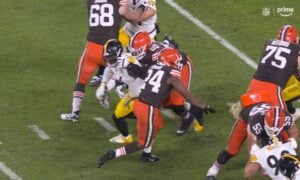In the NFL, all that matters is the outcome. Kendrick Green’s outcome is that he’s a failed Pittsburgh Steelers draft selection. But it’s hard to blame the guy. Without a shred of hyperbole, it might not be the organization’s most costly miss but it’s arguably their worst evaluation of the 21st century.
The result’s all the same. Green won’t be the Steelers’ next great center, but he didn’t fail the team. They failed him.
The desire for a center was real. Pittsburgh wanted and needed to replace the retiring Maurkice Pouncey, who Ben Roethlisberger wasn’t able to talk into playing for one more year so they could ride off into the sunset together. No internal options existed and the team bypassed any free agency choices.
What Pittsburgh said it wanted was a Day One-ready center. Months after drafting Green, Mike Tomlin outlined his criteria for what the team was looking for.
“We knew we were looking for a center who was game ready, and so we were looking for a senior, a guy who played four years of college football like he did at Illinois, as opposed to maybe somebody who was an underclassman with upside who may be less of a finished product.”
Kendrick Green was none of those things…except that he played at Illinois.
He wasn’t a senior. He was an underclassman who declared a year early.
He only played three seasons, redshirting after switching from DT in his freshman season. He played 2018 through 2020.
He was an unfinished product. While he logged time at center at Illinois, he primarily played guard. A move to center was something relatively new to him in the NFL.
After bypassing Creed Humphrey for Najee Harris and Pat Freiermuth, the Steelers landed on Green in Round Three. With little other options, he became the shoehorned, de-facto starter out of the gate in 2021. It was a miserable experience for him and the offense. There’s no need to relitigate what all went wrong but basically everything did. He fell off blocks, got bullied in pass protection, and sometimes just didn’t snap the football.
By the last few weeks of his rookie year, Green had been benched. In part due to a claim of injury but even when he was clearly healthy, J.C. Hassenauer finished out the season. Pittsburgh quickly pivoted in the offseason, smartly signing veteran Mason Cole, who held the fort down well in 2022. Green “battled” Kevin Dotson for the starting left guard spot in camp, but it was hardly a competition and Dotson easily won despite missing some time with an injury. In Pat Meyer’s aggressive pass set system that likes big and long linemen, Green was and is a poor fit. Thankfully, the Steelers’ line stayed remarkably healthy, and Green spent most of the year inactive, failing to register a single snap in regular season action.
Now Green is, at best, on the bubble to make the roster. Due to a lack of options, he’s back at center working second-team behind Cole. It’s the main reason why I’m writing about him now, his name in media circles for the first time in awhile. Maybe he sticks there but the odds still don’t seem good. Pittsburgh isn’t comfortable with him being one snap away from turning to Green, especially in Meyer’s system that demands more 1v1 blocks from the center in pass protection.
But none of that is particularly new territory. Green hasn’t been a successful NFL player. The more interesting question is what made Pittsburgh think he’d be one in the first place.
Had the Steelers gone in a different, better direction, maybe Green could’ve performed. But there was such a disconnect between what the team wanted and what they actually drafted. It’s confounding, honestly. No team hits on every draft pick but Pittsburgh does more often than most and when it misses, it’s usually not because of a total misevaluation or how a player fits into their system or scheme. Green falls into that bucket.
The definition of coaching is putting players in position to succeed. Not setting them up for failure. Nothing Pittsburgh did set Green up for success. They drafted him thinking he was an entirely different prospect with a completely alternative skill set. It’s not even like they planned to sit him and an injury or other unexpected event forced their hand. The Steelers saw the wall in front of them and ran full speed ahead, calling it the right idea along the way.
Maybe it’s an easy scapegoat but I have to think former OL Coach Adrian Klemm helped drive the runaway bus. Ultimately, Kevin Colbert and Mike Tomlin make the call, they’re responsible, but Klemm attended Green’s Illinois’ Pro Day, which carries real weight in Pittsburgh. He had to have produced a glowing report about Green that influenced the selection. And knowing what a poor hire Klemm turned out to be — he didn’t even finish one full year as head o-line coach before leaving for Oregon — that feels like the root of the team’s misevaluation. It doesn’t absolve Tomlin, Colbert, or the rest of the organization from making a bad pick but that’s what makes the most sense.
Had Pittsburgh been more patient, maybe Green would’ve worked. Had Green gone to a heavy-zone system, he might’ve thrived. He’s a legitimately impressive athlete with a mean streak. I don’t want to assume his NFL career was dead on arrival. But Pittsburgh killed it before it had a chance. It remains one of the worst and most confusing picks not just in outcome, which was bad, but especially in process that Kevin Colbert ever made.








